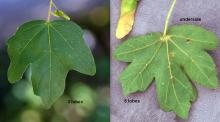Acer campestre
Common name:
Hedge Maple
Field Maple
Common Maple
Pronunciation:
A-ser kam-PES-tree
Family:
Sapindaceae, Aceraceae
Genus:
Type:
Broadleaf
Native to (or naturalized in) Oregon:
No
- Broadleaf deciduous tree, 25-45+ ft (7.6-13.7+ m) high, dense, rounded. Leaves opposite, simple, 5-10 cm, with 3-5 rounded, entire lobes, dark green above, when detached yield a milky sap, a characteristic shared with A. platanoides and A. macrophyllum. Foliage turns yellow or golden in fall, one of the last trees to color. Flowers small, greenish, in upright small, upright pubescent clusters. Fruit (samara) 5 cm long, wings horizontally spreading.
- Sun or light shade. Very adaptable, prefers rich, well-drained soil but performs well in high pH soils and acid soils. Tolerant of dry soils and compaction and air pollution. Considered easy to cultivate as a bonsai.
-
Several selections available, usually from specialty or mail-order nurseries, including:
- ‘Carnival’ - slow growing shrub, to 2-3 m, small leaves with white margins
- ‘Nanum’ (‘Compactum’) - small rounded, very dense shrub, to 4-5 m, leaves smaller than species type
- ‘Postelense’ - spreading shrub, to 3-4 m, leaves gold-yellow in spring, greenish yellow in summer; best in partial shade.
- ‘Pulverulentum’ - low compact shrub, to 2.5 m high, usually wider than tall, white marbled leaves; needs protection from sun
- Queen Elizabeth™ (‘Evelyn’) - fast growing narrow tree, leaves slightly larger than species type
- ‘Royal Ruby’ - shrubby tree, vigorous, to 4.5 m, young leaves purplish-red, very few fruit
- Hardy to USDA Zone (4) 5 Native to Europe, North Africa, and western Asia.
- campestre: of the fields, and it is known as the Field or Common Maple. Often pruned to a hedge in Europe, hence the common name, Hedge Maple.
- Oregon State Univ. campus: east of Milam Hall









